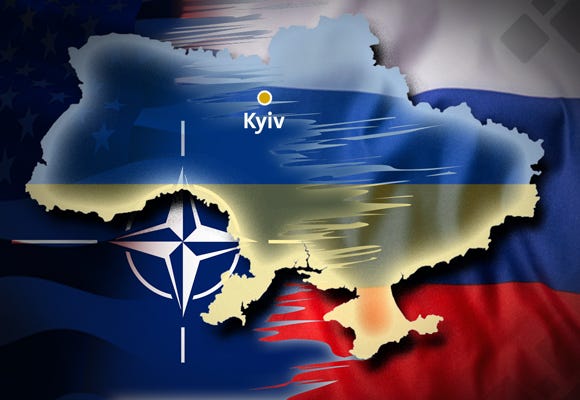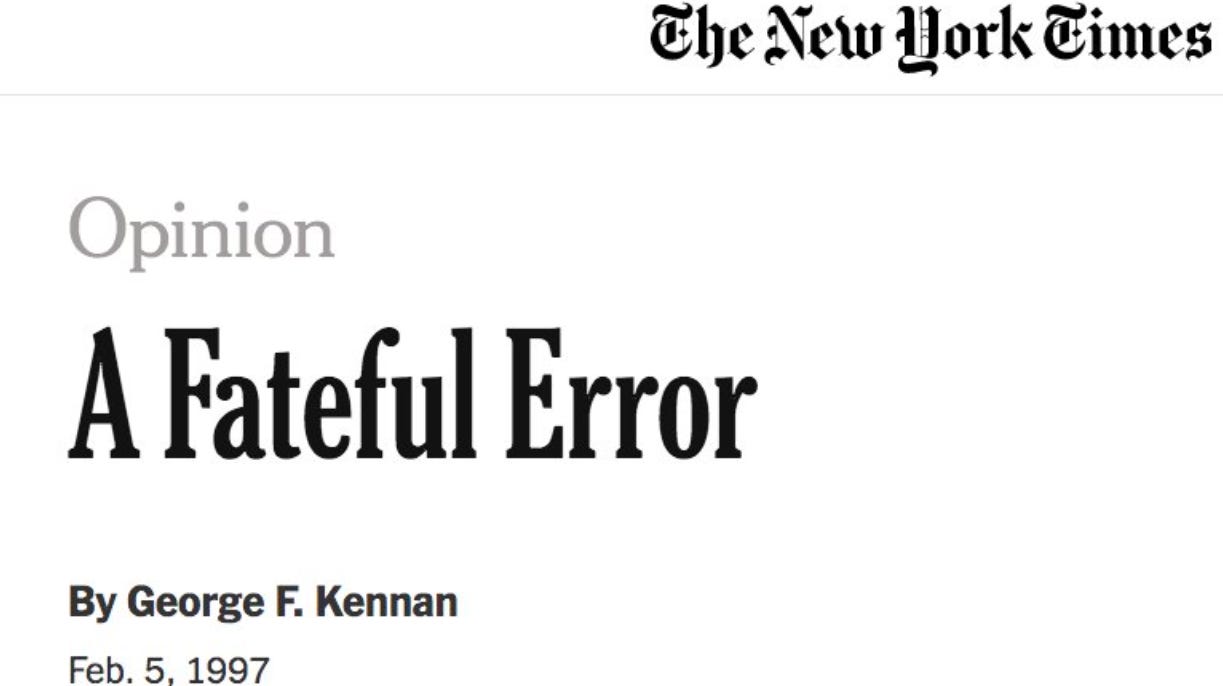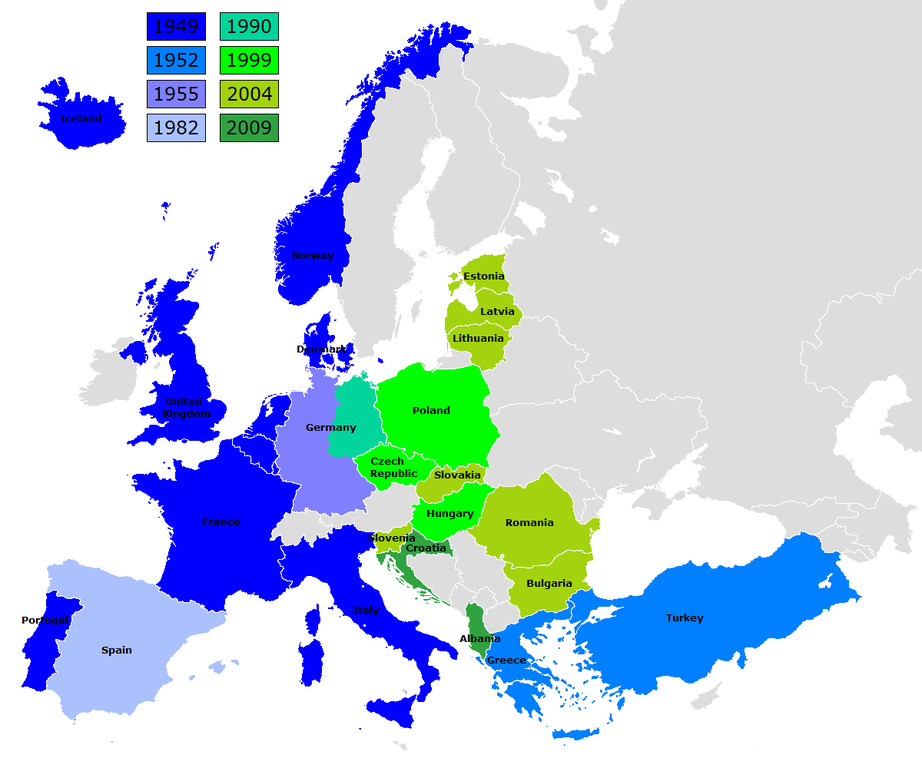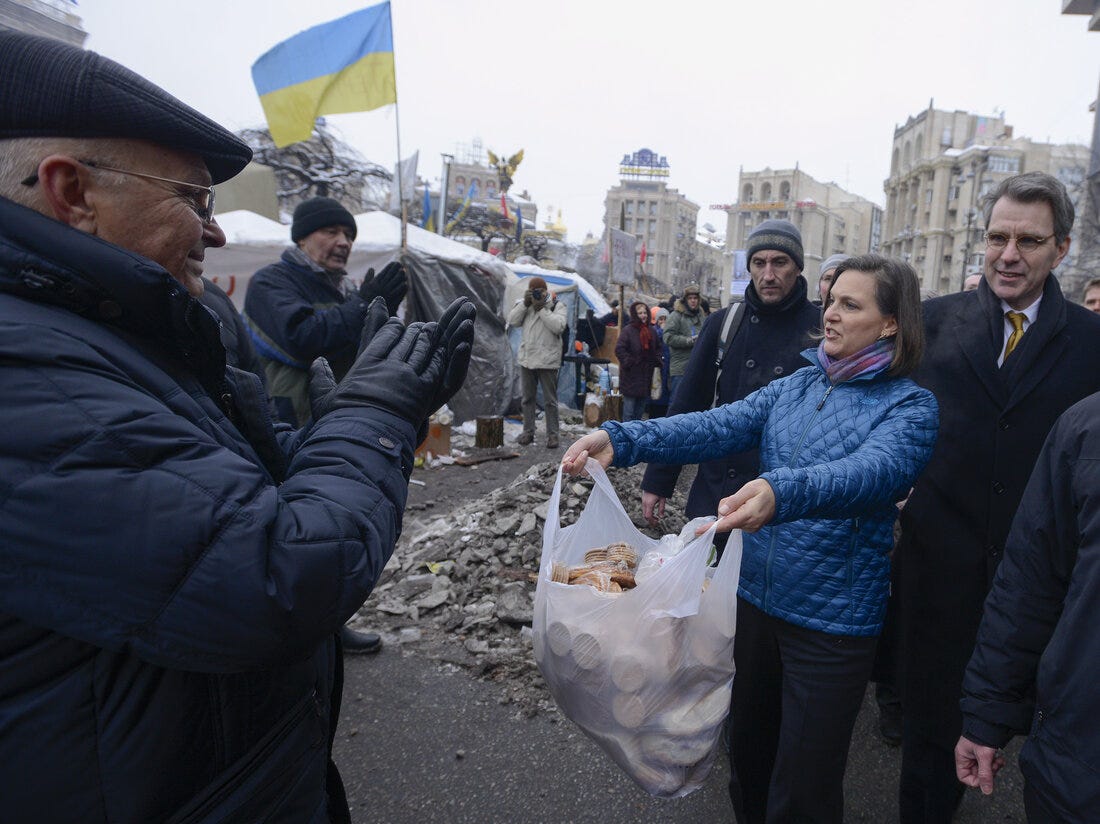The Road to War in Ukraine : A Timeline
This timeline makes clear not only the active role of the US and its allies in getting to a war with Russia, but also to what extent Russia patiently tried to prevent the outbreak of war.
Since 2025 may be a decisive year in the Ukraine conflict, it seems pertinent to make a timeline of the key political events leading up to the Russia armed forces’ entry into Ukraine on February 24th 2022. This timeline starts in 1990, but could have started even earlier with the US support to the Ukrainian nationalists operating inside the USSR in the 1950s
This timeline shows that the Western powers, and in particular Washington D.C., not only did nothing to prevent a war between Ukraine and Russia, but have done everything in their power over several decades to introduce NATO into Ukraine, to achieve regime change in Kiev, and even provoke such a war with Russia.
1990-1991 : Regarding the promises made by the Western powers to the Soviet Union and then to Russia regarding the non-expansion of NATO, documents now show that “Secretary of State James Baker’s famous “not one inch eastward” assurance about NATO expansion in his meeting with Soviet leader Mikhail Gorbachev on February 9, 1990, was part of a cascade of assurances about Soviet security given by Western leaders to Gorbachev and other Soviet officials throughout the process of German unification in 1990 and on into 1991, according to declassified U.S., Soviet, German, British and French documents”.
1991-2014 : Yet, NATO with the USA as the driving force in the “unipolar moment”, was involved in Ukraine from the start, from 1991, with the NATO website openly describing the NATO activities in Ukraine during the 1990s.
1991: Crimea was not part of Ukraine when the Soviet Union dissolved. Crimea officially became an independent Soviet Socialist Republic during the year 1991, before the dissolution of the USSR. The newly independent Ukraine did not therefore include Crimea. A few years later, Crimea was illegally incorporated by the newly declared independent Ukraine, against the wishes of the local population, and against the wishes of Moscow, which was too weak at the time to do much about it.
Aug. 24, 1991 : Ukraine had intended to stay neutral since the beginning, Neutrality was declared first in the Declaration of State Sovereignty of Ukraine, passed on July 1, 1990: Ukraine has the “intention of becoming a permanently neutral state that does not participate in military blocs and adheres to three nuclear free principles” (Declaration of State Sovereignty 1990: Art. IX). Furthermore, the Ukrainian Constitution, which bases itself on the Declaration of Independence of August 24, 1991, contains these basic principles of non-coalition and future neutrality.
Feb. 5, 1997: George Kennan, the legendary US diplomat, famous for his "Long Telegram” in 1946, wrote an op-ed in the New York Times, “A Fateful Error”, where he stated his view that “expanding NATO would be the most fateful error of American policy in the entire post-cold-war era”. James Matlock, the last US ambassador to the USSR, and John Gaddis, American military historian and political scientist, made similar warnings in the 1990s.
Jul. 9, 1997: Despite these sound public warnings by the persons cited above, : “In Madrid on 9 July 1997, the Ukrainian president and NATO heads of state and government signed a Charter for a Distinctive Partnership between NATO and Ukraine.” (according to the NATO Handbook 2005). This is the time when NATO and USEUCOM began using Yavoriv, the Ukrainian military base near the Polish border, as a headquarters and operations center for military exercises.
1999 : NATO expansion begins despite the promises made to Russia, to Yelstine and the Russia leadership. In 1999 were added the Czech Republic, Hungary, and Poland.
2004 : NATO expands again in 2004, adding the Bulgaria, Estonia, Latvia, Lithuania, Romania, Slovakia, and Slovenia.
2004 : Meddling in internal Ukrainian politics really gets under way. The US intelligence agencies and NGOs got deeply involved in the Uktainian political process in the lead up to the Ukrainian presidential elections of 2004, pushing through the “Orange revolution”, and temporarily getting the US-supported candidate Victor Yushchenko in power in Kiev. As the Guardian related at the time: “the campaign is an American creation, a sophisticated and brilliantly conceived exercise in western branding and mass marketing that, in four countries in four years, has been used to try to salvage rigged elections and topple unsavoury regimes. [It was] funded and organised by the US government, deploying US consultancies, pollsters, diplomats, the two big American parties and US non-government organisations”.
Feb. 10, 2007: Putin delivers his well-known Munich security speech, in front of Angela Merkel, John McCain, Condolezza Rice and many other Western leaders. Putin emphasized again how Russia perceived the NATO eastward enlargement as a threat and strongly hinted that for Russia NATO enlargement was directed at Russia. This despite all the past promises that NATO would not expand beyond the incorporation of East Germany into a united Germany as NATO member.
Feb. 1, 2008 : The Biden administration’s CIA Director Bill Burns, was ambassador in Moscow in 2008 when he wrote a memo to Washington, which was made public thanks to Wikileaks. The now famous memo is called “NYET MEANS NYET: RUSSIA'S NATO ENLARGEMENT REDLINES” and explains clearly that “Russia would view further eastward expansion as a potential military threat” and that “Russia is particularly worried that the strong divisions in Ukraine over NATO membership, with much of the ethnic-Russian community against membership, could lead to a major split, involving violence or at worst, civil war.”
Apr. 3, 2008 : Despite this prescient warning from Burns and Putin’s Munich speech a year earlier, the decision was anyway taken at the NATO Summit in Bucharest in 2008 to put Ukraine on an official path to membership : “NATO welcomes Ukraine’s and Georgia’s Euro-Atlantic aspirations for membership in NATO. We agreed today that these countries will become members of NATO. Both nations have made valuable contributions to Alliance operations.” President Sarkozy and Chancellor Merkel were unofficially against it, but did not dare to dissent in view of the US insistence of giving Ukraine a path to membership. Incidentally, several polls in Ukraine showed that up to 2013, the support for NATO membership among Ukrainians was low.
Nov. 21, 2013: The Euromaidan movement starts over the disagreement regarding the partnership agreement with the EU. There were clearly legitimate reasons why Yanukovich was tempted to agree to Russia conditions rather the EU ones. Further, the ground for impactful protests had been already prepared as a consequence of constant US meddling in Ukrainian politics for over a decade. Indeed, apart from the nascent military cooperation with NATO, Victoria Nuland, in 2013 the Assistant Secretary, Bureau of European and Eurasian Affairs at the State Dprt, said that : “Since Ukraine’s independence in 1991, the United States has supported Ukrainians as they build democratic skills and institutions, as they promote civic participation and good governance, all of which are preconditions for Ukraine to achieve its European aspirations. We’ve invested over $5 billion to assist Ukraine in these and other goals that will ensure a secure and prosperous and democratic Ukraine.”
Jan. 28, 2014: A recording of a now notorious “Fuck the EU” telephone call between Nuland and U.S. ambassador to Ukraine Geoffrey Pyatt on January 28, 2014, was published on YouTube (probably recorded and leaked by Russian intelligence), in which they were deciding between themselves over the phone who they wanted see serve in the next Ukrainian government (!). It confirmed that the US was deeply involved in the coup d’état that lead a month later to the toppling of the democratically elected (though corrupt, of course) president Yanukovich and the governement of Ukraine. This was confirmed also by all the financial aid to opposition groups and human rights organisations over the years, mentioned above. Stratfor Director George Friedman, with his links to the US intelligence community, was open about it: “Russia calls the events that took place at the beginning of this year a coup d’etat organized by the United States. And it truly was the most blatant coup in history.”
Feb. 20, 2014: The Maidan shooting by snipers took place on this day. It has been now shown conclusivel by Mr. Kachanovski, that the “Maidan protesters were massacred by snipers located in Maidan-controlled building. […] In contrast to the dominant narrative in the Western media, a German television channel ARD presented evidence showing that snipers had been based in the Hotel Ukraina, and that the government investigation was manipulated. An investigative report by the BBC presented similar evidence, along with a confession by one of Maidan snipers who had shot at the police from the Music Conservatory. Subsequently, several other protesters from far-right-linked Maidan company admitted in the Ukrainian media and social media to shooting and killing the police.”
Feb. 21, 2014: A delegation of European officials arrived in Kiev, to mediate the negotiations and stop the Maidan confrontation. President Yanukovich signed on this day, with the opposition leaders, the Agreement on the Settlement of the Political Crisis in Ukraine, guaranteed by Foreign Minister of Germany Frank-Walter Steinmeier, Foreign Minister of Poland Radosław Sikorski and representative of the French Foreign Ministry Eric Fournier. The document provided for early presidential election and substantial restriction of presidential power. Yanukovich had in effect accepted all demands of the opposition.
Feb. 22, 2014: Yet, the neo-nazi “Right Sector” organization renounced the document signed 24 hours earlier. They demanded Yanukovich’s immediate resignation and dissolution of Verkhovnaya Rada, or else they would assault the Presidency and the Parliament. According to former Ukrainian officials, a task force was assigned to physically eliminate President Yanukovich. In fear for his life, he fled the territory of Ukraine for Russia on the night of February 22, 2014. At that very time, Euromaidan militants led by the ‘Right Sector’ seized the government buildings, including the Presidency, Verkhovnaya Rada, the Cabinet and the Interior Ministry. The European ‘guarantors’ kept silence about the violation of the document they had guaranteed less than 24 hours earlier…
2014 : The arming and the military training of Ukraine by the US started immediatly, though covertly under the Obama presidency. NATO Secretary General Jens Stoltenberg admitted in Feb 2023 the following : “The other thing I will say is that the war didn't start in February last year. The war started in 2014. And since 2014, NATO Allies have provided support to Ukraine, with training, with equipment, so the Ukrainian Armed Forces were much stronger in 2022, than they were in 2020, and 2014.”
Feb. 12, 2015 : The Minsk II agreements were signed on this day. But because of the lack of will and the lack of initiative by Ukraine and its Western garantors to implement it, nothing happened for years, in particular with respect to giving the two Donbas regions more autonomy. In particular, point 11 of the Minsk II required Ukraine to carry out: “Constitutional reform in Ukraine, with a new constitution to come into effect by the end of 2015, the key element of which is decentralisation (taking into account peculiarities of particular districts of Donetsk and Luhansk oblasts, agreed with representatives of these districts), and also approval of permanent legislation on the special status of particular districts of Donetsk and Luhansk oblasts in accordance with the measures spelt out in the attached footnote (appended) by the end of 2015.” France and Germany dragged their feet, as well as Ukraine. In fact, both Porochenko, Merkel and Hollande have all shockingly admitted publicly that the Minsk II agreement was just signed in order to gain time for Ukraine in order to rearm itself. Hollande said : “Since 2014, Ukraine has strengthened its military posture. Indeed, the Ukrainian army was completely different from that of 2014. It was better trained and equipped. It is the merit of the Minsk agreements to have given the Ukrainian army this opportunity.”
Apr. 24, 2019 : On this day, the RAND Corporation published its now (in)famous research report, “Extending Russia”, which,, among other bellicose suggestions, recommends for Washington to push for NATO membership for Ukraine, even if the authors conclude that it cannot really happen : “The United States could also become more vocal in its support for NATO membership for Ukraine. [...] While NATO’s requirement for unanimity makes it unlikely that Ukraine could gain membership in the foreseeable future, Washington’s pushing this possibility could boost Ukrainian resolve while leading Russia to redouble its efforts to forestall such a development.”
March 2021 : Zelensky officially announced that Ukraine would attempt to retake Crimea by force (Decree 117 of March 24, 2021), as well as stating openly and firmly that Kiev would retake the Donbass by force. Russia responded by deploying troops to the border, in order to create deterrence.
Jun. 16, 2021 : The Geneva Summit takes place between Biden and Putin. When Biden took office in 2021, his advisors assured him that he could play on Russia’s fear (!) of China and try to separate the two nations, in order to bring Russia closer to the West. That was the core strategy of the USA for the summit in Geneva, but it didn’t work, as should have been understood already at the time. The US strategy was made clear when Biden outlined what he had said to Putin in Geneva. Returning to Washington, Biden said not very convincingly, “ Russia is in a very, very difficult situation right now. It’s being crushed by China .” But there was no basis for such a comment in reality.
Aug. 2021: This new American strategy under Biden, attempted towards Putin without success by President Biden in June in Geneva, was expressed in great detail in a long article in the National Interest by Wess Mitchell in August 2021.
Sept. 2021 : In the summer of 2021, after the failure of Geneva meeting of 2021, the idea was formed in Washington to inflict a strategic defeat on Russia in Ukraine, to change the government in Moscow altogether if possible, because the Kremlin refused to "cooperate". At a minimum the idea was to force, after such a defeat, Russia to align with Washington and move away from China. This also explains the US’s rapid and rushed withdrawal from Afghanistan during the summer of 2021. As Secretary of State Blinken indicated in September 2021, this withdrawal was clearly in view of an upcoming war with Russia: “There is nothing that strategic competitors like China and Russia – or adversaries like Iran and North Korea – would have liked more than for the United States to reup a 20-year war and remain bogged down in Afghanistan for another decade.”
Summer and Fall 2021 : Putin and Xi spent the rest of 2021 trying to dissuade Biden of his idea of “Chinese pressure” on Russia: it was not pressure, they tried to assure, but a brotherly embrace. This mutual effort culminated in a virtual Xi-Putin summit on December 15 of that year.
Dec. 15, 2021 : Xi-Putin virtual summit. Notably, Xi in this call said: "Sino-Russia relations constitute a model of international collaboration in the 21st century, firmly supporting China's position on safeguarding its core interests and firmly opposing attempts to drive a wedge between our two countries."
Dec. 17, 2021 : Russia sent proposals for agreement to the US and NATO on future security arrangements in Europe. Article 4 of the proposal said : “The United States of America shall undertake to prevent further eastward expansion of the North Atlantic Treaty Organization and deny accession to the Alliance to the States of the former Union of Soviet Socialist Republics.” No serious response was issued from NATO, the documents were dismissed out of hand; the US just confirmed that the “open door policy” of NATO would remain.
Fall and early winter 2021: Offensive weapons shipments from the USA increased, and sanctions preparations by the West were underway well prior to Feb. 24, 2022.
Dec. 2021 : In a telephone conversation on December 30, 2021, Biden assured Putin that “Washington has no intention of deploying offensive strike weapons in Ukraine.” This gave some hope to the Russians of a peaceful outcome of the stand-off.
Dec. 2021, Jan. 2022 : Russian President Putin, Foreign Minister Lavrov and Deputy Foreign Minister Ryabov all indicated officially, over several weeks, that Russia would take certain “military-technical measures” if the course charted for Ukraine by the West, including NATO membership, was not stopped. Yet, this illicited no reaction from Washington.
Jan. 2022 : Russian Foreign Minister Lavrov revealed that when he met with his counterpart, Secretary of State Antony Blinken, in Geneva in January 2022, Blinken claimed that he had not heard about Biden’s commitment to Putin on December 30 2021 about not deploying offensive strike weapons in Ukraine. Blinken instead insisted that in the medium term missiles could well be deployed by the US in Ukraine, and only that the US would be willing to limit their number, Lavrov said. This was probably the moment when the Russians decided that the war in Donbass was inevitable and therefore Russia had to strike first.
Feb. 4, 2022 : Putin-Xi meeting at the Beijing Olympics, where Xi presumably asked Putin to start the special military operation in Ukraine only after the Beijing Olympics had ended (closing ceremony on 20th of February 2022, Russia entered Ukraine on 24th February 2022).
Feb. 16, 2022: Ukraine begins bombing Donbass, in obvious violation of the Minsk agreements. Shelling increase 30 times from the Ukraine side to the Donbass side, compared to the previous average (according to OSCE). Washington empties its embassy in Kiev.
Feb. 18, 2022: Zelensky makes statements at the Munich Security Conference about Ukraine wanting to acquire nuclear weapons again, despite that fact that these nuclear weapons from the 1990s were Soviet, then Russian, hosted on Ukrainian soil - though never Ukrainian (also, they did not have the launch codes). The Russians noted that strikingly, no pushback at all came from the Western leaders present.
Feb. 21, 2022: The Beijing Winter Olympics ended the day before. Russia recognizes the independence of the DNR and the LRN (which they had asked for since 2015), and then sign friendship treaties with them, assuring mutual security.
Feb. 24, 2022: the Russian army with the militias of Donbass (DNR and LNR) enters Ukraine; the Ukraine conflict begins.
Feb. 27, 2022 : Just three days later, there is a first agreement between Russia and Ukraine to conduct negotiations to end the hostilities.
March and early April 2022 : the negotiations between Russia and Ukraine resulted in a draft agreement which consisted in rejecting NATO membership for Ukraine (but no demand for the Donbass to be annexed by Russia), and both sides felt that a settlement was near. But the tentative agreement was scuttled by the West (Washington and Great Britain, but France and Germany were fully aware of it) when UK PM Boris Johnson flew to Kiev on behalf of Washington, met with Zelensky on 9th April 2022, and strongly suggested to him (or told him) to stop all negotiations with Russia, and offering “unwavering support” from the UK and the West. This was confirmed by Ukraine's chief negotiator, David Arakhamia, but also by previous PM Naftali Bennett of Israel, the Turkish Minister of Foreign Affairs, as well as the testimony of the Swiss ambassador to Turkey.









Thank you 😊!
Thank you.